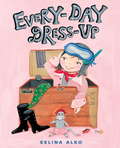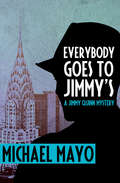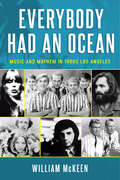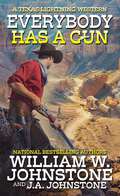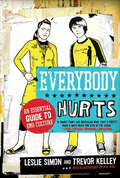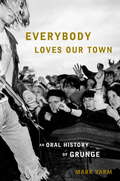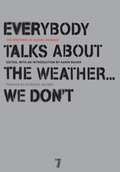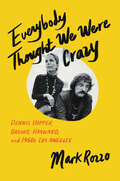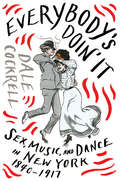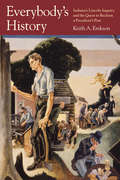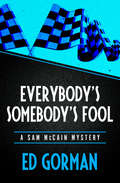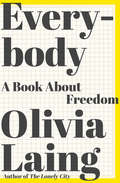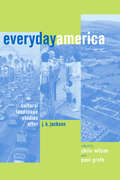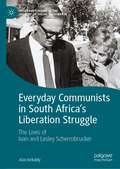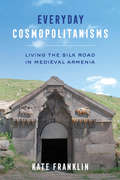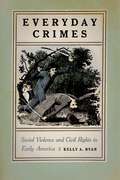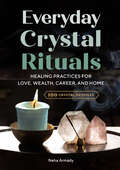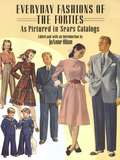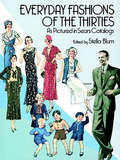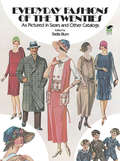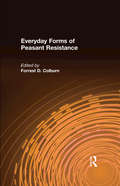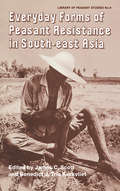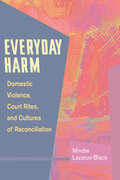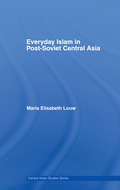- Table View
- List View
Every-Day Dress-Up
by Selina AlkoIt's no secret that little girls love playing dress up, but the little girl in this book ditches her princess duds in favor of costumes inspired by great women in history.Now dressing up is an adventureWhen, every day of the week,I am a daring new dame!From Supreme Court Justice Sonia Sotomayor to chef extraordinaire Julia Child to queen of jazz Ella Fitzgerald, our protagonist pays homage to the women who came before her and imagines herself in their shoes. Maybe someday she'll inspire little girls with her own gown of greatness.From the Hardcover edition.
Everybody Goes to Jimmy's
by Michael MayoAn explosion outside his speakeasy draws Jimmy into a life-or-death chase Young Jimmy Quinn is delivering a bribe for the infamous racketeer Arnold Rothstein when a bomb goes off on Wall Street, killing thirty people and scaring every banker in the city right down to his spats. Twelve years later, Rothstein is dead, and Jimmy is doing his best to stay out of trouble, running a quiet little Manhattan speakeasy. At a particularly bad moment for him and his favorite waitress, a blast rocks the alley outside and draws him right back into the madness of a dozen years ago. That morning, a strange package came in with his liquor shipment: four plain books filled with cryptic numbers. It seems the motive behind this bombing may have been the same as that behind the explosion on Wall Street more than a decade ago: money. The incident sets Jimmy off on a mad race to stay out of the line of fire, taking him from the heights of the Chrysler Building to the depths of New York's underworld.
Everybody Had an Ocean: Music and Mayhem in 1960s Los Angeles
by William MckeenLos Angeles in the 1960s gave the world some of the greatest music in rock 'n' roll history: "California Dreamin'" by the Mamas and the Papas, "Mr. Tambourine Man" by the Byrds, and "Good Vibrations" by the Beach Boys, a song that magnificently summarized the joy and beauty of the era in three and a half minutes.But there was a dark flip side to the fun fun fun of the music, a nexus between naive young musicians and the hangers-on who exploited the decade's peace, love, and flowers ethos, all fueled by sex, drugs, and overnight success. One surf music superstar unwittingly subsidized the kidnapping of Frank Sinatra Jr. The transplanted Texas singer Bobby Fuller might have been murdered by the Mob in what is still an unsolved case. And after hearing Charlie Manson sing, Neil Young recommended him to the president of Warner Bros. Records. Manson's ultimate rejection by the music industry likely led to the infamous murders that shocked a nation.Everybody Had an Ocean chronicles the migration of the rock 'n' roll business to Southern California and how the artists flourished there. The cast of characters is astonishing—Brian and Dennis Wilson of the Beach Boys, Jan and Dean, eccentric producer Phil Spector, Cass Elliot, Sam Cooke, Ike and Tina Turner, Joni Mitchell, and scores of others—and their stories form a modern epic of the battles between innocence and cynicism, joy and terror. You'll never hear that beautiful music in quite the same way.
Everybody Has a Gun (Texas Lightning)
by William W. Johnstone J.A. JohnstoneJOHNSTONE COUNTRY. WHERE LIGHTNING STRIKES ANY PLACE IT WANTS.&“The Fastest Gun in the Territory &” returns—and the ultimate showdown begins—in the latest, greatest Jon Gage adventure from the bestselling Johnstones . . . Like any gunslinger with a bloodstained past, Jon Gage needs to keep moving to stay alive. Too many people know the legend of &“Texas Lightning&”—and too many people want him dead. Trying to keep a low profile, he stops at a supply post in Utah Territory to stock up before hitting the trail. There, he meets a wagon train of farmers from Kansas doing the same. They seem like good, decent folks, but they&’re about to make a very bad decision. The route they&’ve chosen leads straight through the Chosen Valley. Which is like walking through the Valley of the Shadow of Death . . . Ruled by a notorious and powerful cult—known for their cruel and unusual punishments—the Chosen Valley is worse than a dead end. It&’s a trap. Especially for a wagon train of farmers, who are easy targets in a brutal ambush by black-robed zealots. Alerted by the gunshots, Gage tries to help the farmers by donning a robe and infiltrating the cult. What he learns shocks him. The cult plans to kill the farmers, steal their supplies, and force their children into slave labor. Gage is not about to let that happen—even if has to take on the entire cult himself. Every one of them has a gun. But none of them are as fast—or as deadly—as Texas Lightning . . .
Everybody Hurts: An Essential Guide to Emo Culture
by Trevor Kelley Leslie SimonWhat is emo? For starters it's a form of melodic, confessional, or EMOtional punk rock. But emo is more than a genre of music–it's the defining counterculture movement of the '00s. EVERYBODY HURTS is a reference book for emo, tracing its angsty roots all the way from Shakespeare to Holden Caufield to today's most popular bands. There's nothing new about that perfect chocolate and peanut butter combination––teenagers and angst. What is new is that emo is the first cultural movement born on the internet. With the development of early social networking sites like Make Out Club (whose mission is to unite "like–minded nerds, loners, indie rockers, record collectors, video gamers, hardcore kids, and artists through friendship, music, and sometimes even love") outcast teens had a place to find each other and share their pain, their opinions, and above all, their music–which wasn't available for sale at the local record store. Authors Leslie Simon and Trevor Kelley lead the reader through the world of emo including its ideology, music, and fashion, as well as its influences on film, television, and literature. With a healthy dose of snark and sarcasm, EVERYBODY HURTS uses diagrams, illustrations, timelines, and step–by–step instructions to help the reader successfully achieve the ultimate emo lifestyle. Or, alternately, teach him to spot an emo kid across the mall in order to mock him mercilessly.
Everybody Loves Our Town: A History of Grunge
by Mark YarmTwenty years after the release of Nirvana's landmark album Nevermind comes Everybody Loves Our Town: An Oral History of Grunge, the definitive word on the grunge era, straight from the mouths of those at the center of it all. In 1986, fledgling Seattle label C/Z Records released Deep Six, a compilation featuring a half-dozen local bands: Soundgarden, Green River, Melvins, Malfunkshun, the U-Men and Skin Yard. Though it sold miserably, the record made music history by documenting a burgeoning regional sound, the raw fusion of heavy metal and punk rock that we now know as grunge. But it wasn't until five years later, with the seemingly overnight success of Nirvana's "Smells Like Teen Spirit," that grunge became a household word and Seattle ground zero for the nineties alternative-rock explosion.Everybody Loves Our Town captures the grunge era in the words of the musicians, producers, managers, record executives, video directors, photographers, journalists, publicists, club owners, roadies, scenesters and hangers-on who lived through it. The book tells the whole story: from the founding of the Deep Six bands to the worldwide success of grunge's big four (Nirvana, Pearl Jam, Soundgarden and Alice in Chains); from the rise of Seattle's cash-poor, hype-rich indie label Sub Pop to the major-label feeding frenzy that overtook the Pacific Northwest; from the simple joys of making noise at basement parties and tiny rock clubs to the tragic, lonely deaths of superstars Kurt Cobain and Layne Staley. Drawn from more than 250 new interviews--with members of Nirvana, Pearl Jam, Soundgarden, Alice in Chains, Screaming Trees, Hole, Melvins, Mudhoney, Green River, Mother Love Bone, Temple of the Dog, Mad Season, L7, Babes in Toyland, 7 Year Bitch, TAD, the U-Men, Candlebox and many more--and featuring previously untold stories and never-before-published photographs, Everybody Loves Our Town is at once a moving, funny, lurid, and hugely insightful portrait of an extraordinary musical era.From the Hardcover edition.
Everybody Talks About the Weather . . . We Don't: The Writings of Ulrike Meinhof
by Elfriede Jelinek Luise Von Flotow Ulrike Meinhof Bettina Rohl Karin BauerNo other figure embodies revolutionary politics and radical chic quite like Ulrike Meinhof, who formed, with Andreas Baader and Gudrun Ensslin, the Red Army Faction (RAF), also known as the Baader-Meinhof Gang, notorious for its bombings and kidnappings of the wealthy in the 1970s. But in the years leading up to her leap into the fray, Meinhof was known throughout Europe as a respected journalist, who informed and entertained her loyal readers with monthly magazine columns.What impels someone to abandon middle-class privilege for the sake of revolution? In the 1960s, Meinhof began to see the world in increasingly stark terms: the United States was emerging as an unstoppable superpower, massacring a tiny country overseas despite increasingly popular dissent at home; and Germany appeared to be run by former Nazis. Never before translated into English, Meinhof's writings show a woman increasingly engaged in the major political events and social currents of her time. In her introduction, Karin Bauer tells Meinhof's mesmerizing life story and her political coming-of-age; Nobel Prize-winning author Elfriede Jelinek provides a thoughtful reflection on Meinhof's tragic failure to be heard; and Meinhof 's daughter--a relentless critic of her mother and of the Left--contributes an afterword that shows how Meinhof's ghost still haunts us today.
Everybody Thought We Were Crazy: Dennis Hopper, Brooke Hayward, and 1960s Los Angeles
by Mark RozzoThe stylish, wild story of the marriage of Dennis Hopper and Brooke Hayward—a tale of love, art, Hollywood, and heartbreak “Those years in the sixties when I was married to Dennis were the most wonderful and awful of my life.” —Brooke HaywardLos Angeles in the 1960s: riots in Watts and on the Sunset Strip, wild weekends in Malibu, late nights at The Daisy discotheque, openings at the Ferus Gallery, and the convergence of pop art, rock and roll, and the New Hollywood. At the center of it all, one inspired, improbable, and highly combustible couple—Dennis Hopper and Brooke Hayward—lived out the emblematic love story of ’60s L.A.The home these two glamorous young actors created for themselves and their family at 1712 North Crescent Heights Boulevard in the Hollywood Hills became the era’s unofficial living room, a kaleidoscopic realm—“furnished like an amusement park,” Andy Warhol said—that made an impact on anyone who ever stepped into it. Hopper and Hayward, vanguard collectors of contemporary art, packed the place with pop masterpieces by the likes of Roy Lichtenstein, Ed Ruscha, and Warhol, and welcomed a who’s who of visitors, from Jane Fonda to Jasper Johns, Joan Didion to Tina Turner, Hells Angels to Black Panthers. In this house, everything that defined the 1960s went down: the fun, the decadence, the radical politics, and, ultimately, the danger and instability that Hopper explored in the project that made his career, became the cinematic symbol of the period, and blew their union apart—Easy Rider.Everybody Thought We Were Crazy is at once a fascinating account of the Hopper and Hayward union and a deeply researched, panoramic cultural history. It’s the intimate saga of one couple whose own rise and fall—from youthful creative flowering to disorder and chaos—mirrors the very shape of the decade.
Everybody's Doin' It: Sex, Music, And Dance In New York, 1840-1917
by Dale Cockrell"Racy scholarship does the Grizzly Bear here with theoretical rigor." —William Lhamon, author of Raising Cain Everybody’s Doin’ It is the eye-opening story of popular music’s seventy-year rise in the brothels, dance halls, and dives of New York City. It traces the birth of popular music, including ragtime and jazz, to convivial meeting places for sex, drink, music, and dance. Whether coming from a single piano player or a small band, live music was a nightly feature in New York’s spirited dives, where men and women, often black and white, mingled freely—to the horror of the elite. This rollicking demimonde drove the development of an energetic dance music that would soon span the world. The Virginia Minstrels, Juba, Stephen Foster, Irving Berlin and his hit “Alexander’s Ragtime Band,” and the Original Dixieland Jass Band all played a part in popularizing startling new sounds. Musicologist Dale Cockrell recreates this ephemeral underground world by mining tabloids, newspapers, court records of police busts, lurid exposés, journals, and the reports of undercover detectives working for social-reform organizations, who were sent in to gather evidence against such low-life places. Everybody’s Doin’ It illuminates the how, why, and where of America’s popular music and its buoyant journey from the dangerous Five Points of downtown to the interracial black and tans of Harlem.
Everybody's Heard about the Bird: The True Story of 1960s Rock 'n' Roll in Minnesota
by Rick ShefchikIf you didn&’t experience rock and roll in Minnesota in the 1960s, this book will make you wish you had. This behind-the-scenes, up-close-and-personal account relates how a handful of Minnesota rock bands erupted out of a small Midwest market and made it big. It was a brief, heady moment for the musicians who found themselves on a national stage, enjoying a level of success most bands only dream of.In Everybody&’s Heard about the Bird, Rick Shefchik writes of that time in vivid detail. Interviews with many of the key musicians, combined with extensive research and a phenomenal cache of rare photographs, reveal how this monumental era of Minnesota rock music evolved. The chronicle begins with musicians from the 1950s and early 1960s, including Augie Garcia, Bobby Vee, the Fendermen, and Mike Waggoner and the Bops. Shefchik looks at how a local recording studio and record label, along with Minnesota radio stations, helped make their achievements possible and prepared the way for later bands to break out nationally. Shefchik delves deeply into the Trashmen&’s emblematic rise to fame. A Minneapolis band that recorded a fluke novelty hit called &“Surfin&’ Bird&” at Kay Bank Studios, the Trashmen signed with Soma Records, topped the local charts in late 1963, and were poised to top the national charts in early 1964. Hundreds of Minnesota bands took inspiration from the Trashmen&’s success, as teen dances with live bands flourished in clubs, ballrooms, gyms, and halls across the Upper Midwest. Here are the stories of bands like the Gestures, the Castaways, and the Underbeats, and the triumphs—and tragedies—of the most prominent Minnesota-spawned bands of the late 1960s, including Gypsy, Crow, and the Litter.For the baby boomers who remember it and everyone else who has felt its influence, the 1960s rock-and-roll scene in Minnesota was an extraordinary period both in musical history and popular culture, and now it&’s captured fully in print for the first time. Everybody&’s Heard about the Bird celebrates how these bands found their singular sound and played for their elated audiences from the golden era to today.
Everybody's History: Indiana's Lincoln Inquiry and the Quest to Reclaim a President's Past
by Keith A. EreksonRevered by the public, respected by scholars, and imitated by politicians, Abraham Lincoln remains influential more than two hundred years after his birth. His memory has inspired books, monuments, and museums and also sparked controversies, rivalries, and forgeries. That so many people have been interested in Lincoln for so long makes him an ideal subject for exploring why history matters to ordinary Americans as well as to academic specialists. In Everybody's History, Keith A. Erekson focuses on the Southwestern Indiana Historical Society--an organization composed of lawyers, historians, collectors, genealogists, teachers, college presidents, and newspaper editors--who joined together during the 1920s and 1930s to recover a part of Lincoln's life his biographers had long ignored: the years from age seven to twenty-one when he lived on the Indiana frontier. Participants in the "Lincoln Inquiry," as it was commonly known, researched old records, interviewed aging witnesses, hosted pageants, built a historical village, and presented their findings in public and in print. Along the way they defended their methods and findings against competitors in the fields of public history and civic commemoration, and rescued some of Indiana's own history by correcting a forgotten chapter of Lincoln's. Everybody's History traces the development of popular interest in Lincoln to uncover the story of an extensive network of nonprofessional historians who contested old authorities and advanced new interpretations. In so doing, the book invites all who are interested in the past to see history as both vital to public life and meaningful to everybody.
Everybody's Somebody's Fool (The Sam McCain Mysteries #Bk. 5)
by Ed GormanThere is a body in a gazebo, and the chief suspect is not long for this worldSmall-town lawyer and private detective Sam McCain is enjoying a cocktail party, dancing with a lovelier specimen than his five-foot-five-inch frame usually attracts, when the hostess confronts him with a problem the likes of which Good Housekeeping has never seen. There is a corpse in the backyard gazebo, and the party is definitely over.The murdered girl was the twenty-year-old daughter of the town&’s Cadillac dealer, a troubled young woman with a self-destructive streak. The police focus their investigation on her drag-racing boyfriend, local bad boy David Egan, whom McCain agrees to defend. When Egan dies in a freak car accident, the case seems closed. But examining the hot rod shows a cut brake line—and a motive for a killing far more complicated than good girl gone bad.
Everybody: A Book About Freedom
by Olivia Laing"Astute and consistently surprising critic" (NPR) Olivia Laing investigates the body and its discontents through the great freedom movements of the twentieth century. The body is a source of pleasure and of pain, at once hopelessly vulnerable and radiant with power. In her ambitious, brilliant sixth book, Olivia Laing charts an electrifying course through the long struggle for bodily freedom, using the life of the renegade psychoanalyst Wilhelm Reich to explore gay rights and sexual liberation, feminism, and the civil rights movement. Drawing on her own experiences in protest and alternative medicine, and traveling from Weimar Berlin to the prisons of McCarthy-era America, Laing grapples with some of the most significant and complicated figures of the past century—among them Nina Simone, Christopher Isherwood, Andrea Dworkin, Sigmund Freud, Susan Sontag, and Malcolm X. Despite its many burdens, the body remains a source of power, even in an era as technologized and automated as our own. Arriving at a moment in which basic bodily rights are once again imperiled, Everybody is an investigation into the forces arranged against freedom and a celebration of how ordinary human bodies can resist oppression and reshape the world.
Everyday America: Cultural Landscape Studies after J. B. Jackson
by Chris Wilson and Paul GrothAs old as a roadway that was once a Native trail, as new as the suburban subdivisions spreading across the American countryside, the cultural landscape is endlessly changing. The study of cultural landscapes—a far more recent development—has also undergone great changes, ever broadening, deepening, and refining our understanding of the intricate webs of social and ecological spaces that help to define human groups and their activities. Everyday America surveys the widening conceptions and applications of cultural landscape writing in the United States and, in doing so, offers a clear and compelling view of the state of cultural landscape studies today. These essays—by distinguished journalists, historians, cultural geographers, architects, landscape architects, and planners—constitute a critical evaluation of the field’s theoretical assumptions, and of the work of John Brinckerhoff Jackson, the pivotal figure in the emergence of cultural landscape studies. At the same time, they present exemplary studies of twentieth-century landscapes, from the turn-of-the-century American downtown to the corporate campus and the mini-mall. Assessing the field’s accomplishments and shortcomings, offering insights into teaching the subject, and charting new directions for its future development, Everyday America is an eloquent statement of the meaning, value, and potential of the close study of human environments as they embody, reflect, and reveal American culture.
Everyday Communists in South Africa’s Liberation Struggle: The Lives of Ivan and Lesley Schermbrucker (Palgrave Studies in the History of Social Movements)
by Alan KirkaldyThis book explores the role of social movements in the Southern African liberation struggle, through the lens of two ‘everyday communists’. Focusing on the Communist Party of South Africa (CPSA), the author explores the lives of Ivan and Lesley Schermbrucker, whose contribution to the party was more clandestine than that of leaders such as Bram Fischer and Joe Slovo. They represent how ‘ordinary’ people could play significant roles based on stances more rooted in common decency and morality than in Marxist theory. The book also sheds light on the interplay between transnational and national tendencies during the liberation movement, particularly between the 1940s and the 1960s. The Schermbruckers changed their views in response to the shifting national and international political landscape, the rise of Stalinism, and the flight of South African activists into exile from the 1960s. Both fluent in African languages, they were able to create relationships of trust with African members of the CPSA. Examining tensions and conflicts during the liberation struggle, this book provides fresh insights into ‘underground’ activism.
Everyday Cosmopolitanisms: Living the Silk Road in Medieval Armenia
by Kate FranklinA free open access ebook is available upon publication. Learn more at www.luminosoa.org.Widely studied and hotly debated, the Silk Road is often viewed as a precursor to contemporary globalization, the merchants who traversed it as early agents of cultural exchange. Missing are the lives of the ordinary people who inhabited the route and contributed as much to its development as their itinerant counterparts. In this book, Kate Franklin takes the highlands of medieval Armenia as a compelling case study for examining how early globalization and everyday life intertwined along the Silk Road. She argues that Armenia—and the Silk Road itself—consisted of the overlapping worlds created by a diverse assortment of people: not only long-distance travelers but also the local rulers and subjects who lived in Armenia’s mountain valleys and along its highways. Franklin guides the reader through increasingly intimate scales of global exchange to highlight the cosmopolitan dimensions of daily life, as she vividly reconstructs how people living in and passing through the medieval Caucasus understood the world and their place within it. With its innovative focus on the far-reaching implications of local practices, Everyday Cosmopolitanisms brings the study of medieval Eurasia into relation with contemporary investigations of cosmopolitanism and globalization, challenging persistent divisions between modern and medieval, global and quotidian.
Everyday Crimes: Social Violence and Civil Rights in Early America
by Kelly A RyanThe narratives of slaves, wives, and servants who resisted social and domestic violence in the nineteenth centuryIn the early nineteenth century, Peter Wheeler, a slave to Gideon Morehouse in New York, protested, “Master, I won’t stand this,” after Morehouse beat Wheeler’s hands with a whip. Wheeler ran for safety, but Morehouse followed him with a shotgun and fired several times. Wheeler sought help from people in the town, but his eventual escape from slavery was the only way to fully secure his safety. Everyday Crimes tells the story of legally and socially dependent people like Wheeler—free and enslaved African Americans, married white women, and servants—who resisted violence in Massachusetts and New York despite lacking formal protection through the legal system. These “dependents” found ways to fight back against their abusers through various resistance strategies. Individuals made it clear that they wouldn’t stand the abuse. Developing relationships with neighbors and justices of the peace, making their complaints known within their communities, and, occasionally, resorting to violence, were among their tactics. In bearing their scars and telling their stories, these victims of abuse put a human face on the civil rights issues related to legal and social dependency, and claimed the rights of individuals to live without fear of violence.
Everyday Crystal Rituals: Healing Practices for Love, Wealth, Career, and Home
by Naha ArmádyManifest desires with crystal healing prescriptions for your home, career, and relationship from Everyday Crystal Rituals. Crystal rituals channel inner desires to create outward change. In Everyday Crystal Rituals, you'll learn practical applications to crystal healing and manifest the life you want to lead at home, work, and in love. From mending broken hearts, to removing career obstacles, to inviting creativity into your home, these rituals make sacred practices part of your daily routine. Complete with 100 crystal profiles that explain their individual healing powers, plus an introduction on tuning into crystal energy, Everyday Crystal Rituals is your down-to-earth guide for healing with crystals. Everyday Crystal Rituals awakens your ability to live in fulfillment, love, and abundance with: An introduction to crystal healing that explains how to call on crystal energy and manifest powerful intentions with purpose. 60 rituals for focused healing of real obstacles around love and relationships, career, wealth, and home life. 100 profiles of the most common crystals with practical information on how to use them to achieve your life goals. Whether you're new to working with crystals or they're already a big part of your life, Everyday Crystal Rituals makes manifesting positive change a daily ritual.
Everyday Fashions of the Forties As Pictured in Sears Catalogs
by Joanne OlianFew publications illustrate so comprehensively what American men, women, and children wore in the 1940s than the Sears catalogs of those years, when the company's fashions typified the tastes of the American mainstream. This book is a compilation of 122 fully illustrated and captioned pages selected and reproduced from rare copies of Sears catalogs of the World War II era.Over 120 large-format pages have been carefully reprinted on high-quality glossy stock. They reveal in sharp detail the broad range of clothing fashions available during a period when wartime gasoline rationing made mail-order shopping reach new heights of popularity.Hundreds of accurately detailed drawings depict articles of clothing and personal accessories, including hats, overcoats, shoes, dresses, sportswear, undergarments, neckties, and more. Styles for children range from play clothes to "Sunday best." Men's clothing reflects the conservativism in male fashions during the period. Women's wear ranges from slacks, newly popular with women in the workforce, to dresses with plenty of "Oomph."Here is a richly revealing document that historians of costume and readers interested in fashion, social history, and Americana will find endlessly fascinating. JoAnne Olian, curator of the Costume Collection at the Museum of the City of New York, has written an introduction that appraises the fashions of the 1940s and the many ways in which they reflected the times.
Everyday Fashions of the Thirties As Pictured in Sears Catalogs
by Stella BlumFor thousands of women across America, hard hit when the frivolity of the twenties ended so resoundingly with the Crash of '29, the pages of the Sears catalog became an essential resource in maintaining a wardrobe. An ambitious marketing operation, it could not afford to take chances on haute couture; its fashions were geared as closely as possible to the prevailing tastes of the American people. For this historically accurate sampling of authentic 1930s fashion, Stella Blum, former Curator of the Costume Institute at the Metropolitan Museum of Art in New York, selected for reproduction 133 representative pages from rare Sears catalogs of the period (fall and spring catalog for each year from 1930 to 1939). Hundreds of illustrations record what men, women, and children were actually wearing in the 1930s when, as a copyline from the Fall 1930 catalog proclaimed: "Thrift is the spirit of the day. Reckless spending is a thing of the past."You'll see here how simpler women's fashion designs -- of more traditional, affordable material -- recaptured the feminine form with a more natural waistline and lower hemlines than seen in the twenties. For evening wear, longer dresses replaced flamboyant beaded short gowns while cloche hats, another twenties trademark, were replaced by berets, pillboxes, and turbans. The seriousness of the accessories and dresses endorsed by such Hollywood legends as Loretta Young, Claudette Colbert, and Fay Wray.For historians of costume, nostalgia buffs and casual browsers, these pages afford a rare picture of how the average American really dressed during the thirties. It is an essential resource for study of the clothing of an important era which designers cannot afford to be without.
Everyday Fashions of the Twenties: As Pictured in Sears and Other Catalogs
by Stella BlumThe Roaring Twenties, age of jazz and flappers, Model T Fords and Hollywood movie stars, was also a time when for millions the bulky catalogs of Montgomery Ward or Sears, Roebuck were a substitute for the window displays of Paris or New York fashion shops. Buying clothing through the mails had become an American institution, and entire families were often dressed via the U.S. Post Office. More conservative than the up-to-the-minute fashion shops, mail-order catalogs nevertheless offered surprisingly much of the haute couture. But, above all, they accurately record what men, women, and children were actually wearing in the 1920s.Now Stella Blum (Curator of the Costume Institute at the Metropolitan Museum of Art, New York) has distilled into this volume the essence of the fashion pages of the Sears, Roebuck and other mail-order catalogs of the Twenties. Her informative text and selection of over 150 representative catalog pages -- comprising over 750 illustrations with original captions -- gradually trace the evolution of dress modes from the vogue of stodgy postwar fashions to the impact on costume of the crash of '29. In a year-by-year survey, Mrs. Blum's introductory texts relate the trends in fashion to the social changes of the dynamic and restless era, assessing the influence of war and technological developments on the high hemlines, flattened busts and hips, geometric patterns and "bobbed" hairstyles of the boyish flapper look. And as she notes, it was through the Sears catalogs that Parisian designers like Coco Chanel, Jeanne Lanvin, and Madeleine Vionnet made their influence felt on Midwestern farms and in urban ghettos.You'll find here a marvelous panorama of "smart," "modish," "chic," "stylish," and "ultra fashionable" apparel, as well as more traditional garments: for women and "misses" there are Middy blouses, Russian boots modeled by Gloria Swanson, "Bob" hats modeled by Clara Bow and Joan Crawford; coats, suits, dresses (including the first maternity dresses), sweaters, capes; silk and rayon stockings, corsets, chemises, camisoles, negligees; and accessories like necklaces, belts, combs, headbands, umbrellas, gloves, compacts, hand bags, wristwatches, and powderpuff cases. You'll see slower-to-change men's fashions -- shirts, ties, suits, sweaters, and sports clothes -- become trimmer, brighter, smarter. And you can follow the trends in children's fashions as well.For historians of costume, nostalgia buffs, and casual browsers, these pages afford a rare picture -- unspoiled by recent myths about the Roaring Twenties -- of how average people really dressed in the jazz age.
Everyday Forms of Peasant Resistance
by Forrest D. ColburnPeasant rebellions are uncommon. "Everyday Forms of Peasant Resistance" explores peasants' foot dragging, feigned ingorance, false compliance, manipulation, flight, slander, theft, arson, sabotage, and similar prosaic forms of struggle. These kinds of resistance stop well short of collective defiance, a strategy usually suicidal for the subordinate. The central argument about peasant resistance is presented in the opening chapter by James Scott in which he summarizes and extends the thesis of his book on Malaysia's peasantry, "Weapons of the Weak". Scott's ideas are employed and refined in the ensuing seven country studies of peasant resistance: Poland, India, Egypt, Colombia, China, Nicaragua and Zimbabwe.
Everyday Forms of Peasant Resistance in South-East Asia: Everyday Forms Res Asia
by James C. Scott and Benedict J. Tria KerkvlietFirst published in 1987. Routledge is an imprint of Taylor & Francis, an informa company.
Everyday Harm: Domestic Violence, Court Rites, and Cultures of Reconciliation
by Mindie Lazarus-BlackExposing the powerful contradictions between empowering rights and legal rites By investigating the harms routinely experienced by the victims and survivors of domestic violence, both inside and outside of law, Everyday Harm studies the limits of what domestic violence law can--and cannot--accomplish. Combining detailed ethnographic research and theoretical analysis, Mindie Lazarus-Black illustrates the ways persistent cultural norms and ingrained bureaucratic procedures work to unravel laws designed to protect the safety of society’s most vulnerable people. Lazarus-Black’s fieldwork in Trinidad traces a story with global implications about why and when people gain the right to ask the court for protection from violence, and what happens when they pursue those rights in court. Why is itthat, in spite of laws designed to empower subordinated people, so little results from that legislation? What happens in and around courts that makes it so difficult for people to obtain their legally available rights and protections? In the case of domestic violence law, what can such legislation mean for women’s empowerment, gender equity, and protection? How do cultural norms and practices intercept the law?
Everyday Islam in Post-Soviet Central Asia (Central Asian Studies #Vol. 7)
by Maria Elisabeth LouwProviding a wealth of empirical research on the everyday practise of Islam in post-Soviet Central Asia, this book gives a detailed account of how Islam is understood and practised among ordinary Muslims in the region, focusing in particular on Uzbekistan. It shows how individuals negotiate understandings of Islam as an important marker for identity, grounding for morality and as a tool for everyday problem-solving in the economically harsh, socially insecure and politically tense atmosphere of present-day Uzbekistan. Presenting a detailed case-study of the city of Bukhara that focuses upon the local forms of Sufism and saint veneration, the book shows how Islam facilitates the pursuit of more modest goals of agency and belonging, as opposed to the utopian illusions of fundamentalist Muslim doctrines.
